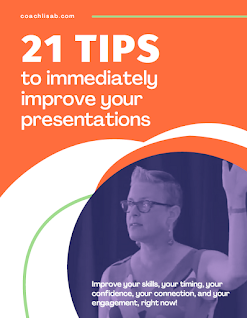How does the audience know when you're done?
 On Sunday, I watched a performance of a competitive cheer team (I don't think they call it cheerleading any more. . . ). Their routine was astounding, as they tossed tiny girls into the air like tennis balls. The tiny girls kicked, rolled and flipped in midair like it was nothing.
On Sunday, I watched a performance of a competitive cheer team (I don't think they call it cheerleading any more. . . ). Their routine was astounding, as they tossed tiny girls into the air like tennis balls. The tiny girls kicked, rolled and flipped in midair like it was nothing.Unfortunately, this group hadn't practiced their closing as well as they had practiced their routine. We knew they were starting because an announcer introduced them, and their music came on.
However, when the routine ended, and the music ended, they didn't know what to do. No one had prepped them, taught them to take a bow or do whatever cheer teams do at the end of their routines.
They stood there, shuffling their feet, looking nervously at the audience and whispering to each other. Then a couple of girls decided to do backflips. We applauded. One group decided to do another trick, and tossed someone into the air. We hooted and hollered. Finally, they started drifting away, and we determined that the routine was over.
Contrast this with a group called "L.A. Salsa Kids." And I'm not just writing about them because my husband's niece is in the group. . .
The group took the stage and the group leader, a 17-year-old named Justine, introduced them to the audience. She talked a little about the history of the group and explained what they do. Then they performed their first routine.
After the routine, Justine again took the microphone. This time, she introduced the dancers, and played a game with the audience to give away free merchandise.
This interaction happened after each routine, even inviting audience members to come up and compete for prizes by salsa dancing for one minute. There were two little boys who really earned their winnings!
At the end, Justine again introduced each dancer, thanked the audience, mentioned the group's website, and the group took their final bow.
There was a beginning, middle and end. There was no confusion about whether they had started or when they were finished. The audience interaction in between kept the crowd engaged and entertained from start to finish.
After the performance, I complimented Justine's mother on her daughter's poise and professionalism (Justine also teaches the group). Justine's mom mentioned that Justine happened to be sick and was feeling really crummy.
Now I was even more impressed, realizing that this young woman truly understands the concept of "the show must go on." She's been dancing since the age of 2, so I'm sure she learned this early on.
Whether you're a dancer, cheerleader, speaker, singer or stand up comedian, you always need an opening and a closing. The opening grabs your audience's attention and makes them want to pay attention. The closing, at minimum, lets them know you're done, but also leaves them with a strong positive feeling about you, energy and excitement, and a motivation to do something after they leave.
Don't leave your audience hanging, awkwardly wondering if you're finished.
____________________________________________________
On The Everything Page you'll find everything you need to build visibility, credibility and influence through engaging presentations that move your participants into action: freebies, low-cost products and courses, and 1:1 coaching!



0 comments. Please add yours! :
Post a Comment